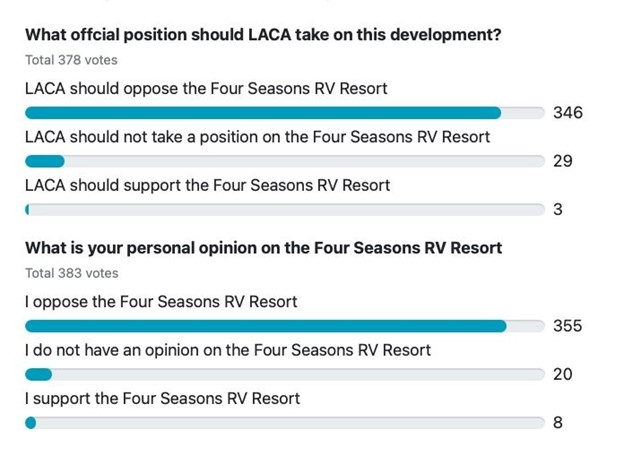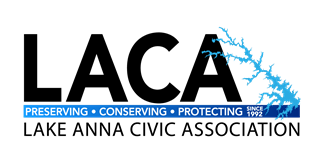By Greg Baker - June 2021
Annual Meeting/Bundles/Volunteers/RV Park
Annual Meeting
The LACA board is happy to announce our annual meeting will be held in person on July 31st from 9:00 AM until 11:00 AM at the North Anna Nuclear Information Center. (Dominion Energy has graciously agreed to host our meeting.) Please check our website’s home page for details. Due to space limitations, our annual meeting is only open to LACA members. Please arrive at 9:00 to have informal breakout sessions with our committee chairs and meet our board members. The official meeting will begin at 9:30.
 We are excited to announce that Professor David Schmale, the head of the Schmale Laboratory at Virginia Tech will be our guest speaker. Dr. Schmale and his team have been working with LACA over the past two years to study Harmful Algae Blooms (HAB) and their causes at Lake Anna with the use of drones. Dr. Schmale was the first to develop an autonomous drone to sample microorganisms in the lower atmosphere and is a renowned expert in HAB.
We are excited to announce that Professor David Schmale, the head of the Schmale Laboratory at Virginia Tech will be our guest speaker. Dr. Schmale and his team have been working with LACA over the past two years to study Harmful Algae Blooms (HAB) and their causes at Lake Anna with the use of drones. Dr. Schmale was the first to develop an autonomous drone to sample microorganisms in the lower atmosphere and is a renowned expert in HAB.
What is a BUNDLE and why should you care?
Our website provider considers each of our members a “bundle” which allows for two people per household to be included on your LACA membership. The bundle administrator is the lead person on the membership and the only person in the household that has the right to vote in our elections. A bundle member is a second person in the household that can be added to your membership.
Why is this important?
Both bundle administrators and bundle members receive our monthly newsletter and our E-Grams with timely and important information from LACA. Most importantly, both members of your household can and should respond to our biennial survey which shapes the direction of our organization. We encourage you to add your spouse or significant other so their voice can also be heard. The survey will be distributed to both bundle administrators and bundle members in late June.
Steps to add a bundle member to your household membership:
1: Go to our website at www.lakeannavirginia.org and make sure you are logged in with your email and password.
2: Once logged in to the LACA website, click on your name at the very top of the home page and you will be brought to your profile page.
3: Just after the Membership details, under the section titled, Bundle Summary, click on Add a Member and follow the prompts. Only one additional household (bundle) member is allowed per membership.
Please note that if you have your spouse or significant other’s email under your profile, please edit your profile and remove that email address to prevent duplicate communications from going to that address. If you would like to swap the bundle administrator and the bundle member for voting privileges, please email me at greg.baker@lakeanavirginia.org
Volunteers Desperately Needed!

Our long time Land Use Committee Chairman and Belmont Regional Director, Allan Lassiter and our Assistant Treasurer, Scott Webster are both sadly selling their lake homes and moving out of the area. This is a huge loss to your LACA board, their contributions to LACA have been immeasurable!
In our normally scheduled election cycle, the following positions are up for election this July: President, Treasurer & Regional Directors for Belmont and Partlow voting districts within Spotsylvania County.
Alan Bennett and I have agreed to run for reelection for the positions of President and Treasurer. However, we strongly encourage anyone interested in either of these positions to volunteer.
The following positions are or will soon be vacant and we are desperately seeking volunteers to get involved with LACA and help preserve and protect the lake.
Land Use Committee Chairman
Assistant Treasurer
Belmont Regional Director
Partlow Regional Director
If you are interested in learning more about the regional Director position, please click here.
If you are interested in learning more about the board, the time commitment, how the elections work or interested in volunteering in some other capacity than the positions above, please email me at greg.baker@lakeannavirginia.org
Four Seasons RV Resort Poll Update
LACA recently conducted a poll of our membership on the proposed Four Seasons RV resort on the Upper Pamunkey Creek. Part of LACA’s mandate in preserving and protecting Lake Anna is monitoring development around the lake. LACA will likely never “support” a development and rarely “opposes” a development unless it is considered especially egregious. (An exception might be a desperately needed urgent care center or a fire & rescue expansion at the lake like the one being proposed at New Bridge.)
Our goal is to work with the developer, the planning commission and the board of supervisors in the early stages of a proposed development to help encourage positive changes. We have met with the Four Seasons developer twice and had several text/calls with them requesting improvements/alterations with their plans. They have made some concessions. For example, they have agreed to lower the number of docks from 300 to 49.
LACA has heard more from our membership on the proposed Four Seasons development than any other development in recent memory. This along with the proposed location of a commercial endeavor on such an environmentally fragile section of the lake caused our board to poll our membership to determine the views of our membership and whether our membership thinks we should take a position on this particular development.
The poll was conducted over 3 days, and we had an overwhelming response with close to 400 members expressing a view. We had numerous productive comments as well. Over 93% of or members opposed the development and over 91% of our members fell that we should officially oppose the development. The results are summarized below:
LACA recently met with staff of the planning commission to express our concerns with the development and share some of our suggestions. If you would like to see the Power Point Presentation that was made on your behalf, there is a link to the presentation on our website here.
greg.baker@lakeannavirginia.org
